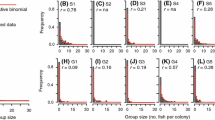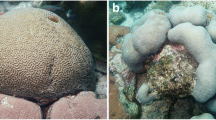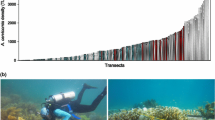Abstract
Spatial heterogeneity plays an important role in consumer–resource interactions. It arises from variability in the underlying distribution of the resource and/or the consumer, as well as the habitat in which the consumer–resource interaction occurs. In some cases, the resource is the habitat, especially when the habitat is biogenic (e.g., kelp, corals, seagrasses). In these systems, the resulting dynamics can be particularly rich because the consumer–resource interactions are coupled with changes in the habitat (i.e., resource) that are due to the consumer–resource interaction. In Moorea, French Polynesia, two corallivorous snails, Coralliophila violacea and Drupella cornus, feed and live on massive Porites corals. Here, I (1) document the spatial patterns of the snails among sites, within sites, and on corals; (2) examine the drivers of small-scale aggregations by testing the attraction of the snails to chemical cues coming from conspecifics and corals; (3) test the effects of aggregations of snails on coral growth by manipulating snail density. The distributions of both snails were highly heterogeneous among sites across the island, and both species were spatially aggregated both among and within corals. The source of chemical attraction that caused the small-scale clustering differed between the two snails. D. cornus was attracted to conspecifics and to corals damaged by conspecifics, whereas C. violacea was attracted to damaged corals (regardless of the cause). Increasing snail density caused a linear decline in coral growth that was similar for the two snail species. The combination of the clustered spatial pattern of both snail species and their negative effects on coral growth could lead to important feedbacks in which high densities of snails reduce coral cover in localized areas and create spatial dynamics that affect the spatial distributions of both corals and snails across the reef.




Similar content being viewed by others
References
Al-Horani FA, Hamdi M, Al-Rousan SA (2011) Prey selection and feeding rates of Drupella cornus (Gastropoda: Muricidae) on corals from the Jordanian coast of the Gulf of Aqaba, Red Sea. Jordan J Biol Sci 4:191–198
Baums I, Miller M, Szmant A (2003) Ecology of a corallivorous gastropod, Coralliophila abbreviata, on two scleractinian hosts. ii. feeding, respiration and growth. Marine Biology 142:1093–1101
Boucher LM (1986) Coral predation by muricid gastropods of the genus Drupella at Enewetak, Marshall Islands. Bull Mar Sci 38:9–11
Brawley SH, Adey WH (1982) Coralliophila abbreviata: a significant corallivore! Bull Mar Sci 32:595–599
Bright AJ, Cameron CM, Miller MW (2015) Enhanced susceptibility to predation in corals of compromised condition. PeerJ 3:e1239
Bruckner AW, Coward G, Bimson K, Rattanawongwan T (2017) Predation by feeding aggregations of Drupella spp. inhibits the recovery of reefs damaged by a mass bleaching event. Coral Reefs 36:1181–1187
Chesher RH (1969) Destruction of Pacific corals by the sea star Acanthaster planci. Science 165:280–283
Couch C, Garriques J, Barnett C, Preskitt L, Cotton S, Giddens J, Walsh W (2014) Spatial and temporal patterns of coral health and disease along leeward Hawaiian island. Coral Reefs 33:693–704
Cumming R (1999) Predation on reef-building corals: multiscale variation in the density of three corallivorous gastropods, Drupella spp. Coral Reefs 18:147–157
Davies PS (1989) Short-term growth measurements of corals using an accurate buoyant weighing technique. Mar Biology 101:389–395
Glynn PW (1980) Defense by symbiotic crustacea of host corals elicited by chemical cues from predator. Oecologia 47:287–290
Guzner B, Novplansky A, Shalit O, Chadwick NE (2010) Indirect impacts of recreational scuba diving: patterns of growth and predation in branching stony corals. Bull Mar Sci 86:727–742
Hoeksema B, Scott C, True J (2013) Dietary shift in corallivorous Drupella snails following a major bleaching event at Koh Tao, Gulf of Thailand. Coral Reefs 32:423–428
John R, Dalling JW, Harms KE, Yavitt JB, Stallard RF, Mirabello M, Hubbell SP, Valencia R, Navarrete H, Vallejo M, Foster RB (2007) Soil nutrients influence spatial distributions of tropical tree species. Proceedings of the National Academy of Sciences 104:864–869
Johnson MS, Holborn K, Black R (1993) Fine-scale patchiness and genetic heterogeneity of recruits of the corallivorous gastropod Drupella cornus. Marine Biology 117:91–96
Kahle D, Wickham H (2013) ggmap: Spatial Visualization with ggplot2. The R Journal 5(1):144–161
Kayal M, Lenihan HS, Pau C, Penin L, Adjeroud M (2011) Associational refuges among corals mediate impacts of a crown-of-thorns starfish Acanthaster plancoutbreak. Coral Reefs 30:827–837
Kita M, Kitamura M, Koyama T, Teruya T, Matsumoto H, Nakano Y, Uemura D (2005) Feeding attractants for the muricid gastropod Drupella cornus, a coral predator. Tetrahedron Lett 46:8583–8585
Lenihan HS, Holbrook SJ, Schmitt RJ, Brooks AJ (2011) Influence of corallivory, competition, and habitat structure on coral community shifts. Ecology 92:1959–1971
Lin TY, Liu LL (2008) Low levels of genetic differentiation among populations of the coral-inhabiting snail Coralliophila violacea (Gastropoda: Coralliophilidae) in regions of the Kuroshio and South China Sea. Zool Stud 47:17
Marsh JA Jr (1970) Primary productivity of reef-building calcareous red algae. Ecology 51:255–263
McClanahan T (1990) Kenyan coral reef-associated gastropod assemblages: distribution and diversity patterns. Coral Reefs 9:63–74
McClanahan, TR (1997) Dynamics of Drupella cornus populations on Kenyan coral reefs Proc 8th lnt Coral Reef Sym 1: 633-638
McKeon CS, Moore JM (2014) Species and size diversity in protective services offered by coral guard crabs. PeerJ Prepr 2:e574
McKeon CS, Stier AC, McIlroy SE, Bolker BM (2012) Multiple defender effects: synergistic coral defense by mutualist crustaceans. Oecologia 169:1095–1103
Miller M (2001) Corallivorous snail removal: evaluation of impact on Acropora palmata. Coral Reefs 19:293–295
Moerland MS, Scott CM, Hoeksema BW (2016) Prey selection of corallivorous muricids at koh tao (Gulf of Thailand) four years after a major coral bleaching event. Contrib Zool 85:291–310
Oren U, Brickner I, Loya Y (1998) Prudent sessile feeding by the corallivore snail, Coralliophila violacea on coral energy sinks. Philos Trans R Soc Lond B Biol Sci 265:2043–2050
Penin L, Michonneau F, Baird AH, Connolly SR, Pratchett MS, Kayal M, Adjeroud M (2010) Early post-settlement mortality and the structure of coral assemblages. Mar Ecol Prog Ser 408:55–64
Potkamp G, Vermeij MJ, Hoeksema, BW (2016) Host-dependent variation in density of corallivorous snails (Coralliophila spp.) at curaçao, southern caribbean. Mar Biodivers: 1–9
Pratchett MS (2001) Influence of coral symbionts on feeding preferences of crown-of-thorns starfish Acanthaster plancin the western Pacific. Mar Ecol Prog Ser 214:111–119
Pratchett M, Vytopil E, Parks P (2000) Coral crabs influence the feeding patterns of crown-of-thorns starfish. Coral Reefs 19:36–36
Rotjan RD, Lewis SM (2008) Impact of coral predators on tropical reefs. Mar Ecol Prog Ser 367:73–91
Rotjan RD, Dimond JL, Thornhill DJ, Leichter JJ, Helmuth B, Kemp DW, Lewis SM (2006) Chronic parrotfish grazing impedes coral recovery after bleaching. Coral Reefs 25(3):361–368
Schoepf V, Herler J, Zuschin M (2010) Microhabitat use and prey selection of the coral-feeding snail Drupella cornus in the northern Red Sea. Hydrobiologia 641:45–57
Seidler TG, Plotkin JB (2006) Seed dispersal and spatial pattern in tropical trees. PLoS Biol 4:e344
Shafir S, Gur O, Rinkevich B (2008) A Drupella cornus outbreak in the northern gulf of eilat and changes in coral prey. Coral Reefs 27:379–379
Skaug H, Fournier D, Nielsen A, Magnusson A, Bolker B. (2011) glmmADMB: Generalized Linear Mixed Models Using AD Model Builder. http://glmmadmb.r-forge.r-project.org, http://admb-project.org. R package version 0.7
Soong K, Chen JL (1991) Population structure and sex-change in the coral-inhabiting snail Coralliophila violacea at Hsiao-Liuchiu. Taiwan. Marine Biology 111:81–86
Stewart HL, Holbrook SJ, Schmitt RJ, Brooks AJ (2006) Symbiotic crabs maintain coral health by clearing sediments. Coral Reefs 25:609–615
Stier A, McKeon C, Osenberg C, Shima J (2010) Guard crabs alleviate deleterious effects of vermetid snails on a branching coral. Coral Reefs 29:1019–1022
Stier AC, Gil MA, McKeon CS, Lemer S, Leray M, Mills SC, Osenberg CW (2012) Housekeeping mutualisms: do more symbionts facilitate host performance? PLoS One 7:e32079
Taylor JD (1978) Habitats and diet of predatory gastropods at Addu Atoll, Maldives. J Exp Mar Bio Ecol 31:83–103
Thaker M, Vanak AT, Owen CR, Ogden MB, Niemann SM, Slotow R (2011) Minimizing predation risk in a landscape of multiple predators: effects on the spatial distribution of african ungulates. Ecology 92:398–407
Turner S (1994a) Spatial variability in the abundance of the corallivorous gastropod Drupella cornus. Coral Reefs 13:41–48
Turner SJ (1994b) The biology and population outbreaks of the corallivorous gastropod Drupella on Indo-Pacific reefs. Oceanogr Mar Biol Ann Rev 32:461–530
Williams DE, Miller MW (2005) Coral disease outbreak: pattern, prevalence and transmission in Acropora cervicornis. Mar Ecol Prog Ser 301:119–128
Wilson WG, Harrison SP, Hastings A, McCann K (1999) Exploring stable pattern formation in models of tussock moth populations. J Anim Ecol 68:94–107
Zeid MA, Kotb MM, Hanafy MH (2004) The impact of the corallivore gastropod Coralliphilia violacea on coral reefs at El-Hamrawain, Egyptian Red Sea coast. Egyptian Journal of Biology 1:124–132
Acknowledgements
I thank Julie Zill, Angela Mulligan, and Morgan Farrell for field assistance and the Osenberg laboratory for helpful discussions. Funding was provided by National Science Foundation OCE-1130359, the QSE3 IGERT program (Grant No. 0801544), and the French American Cultural Exchange (via their support of the “Ocean Bridges” program). This project was conducted at the Richard B. Gump South Pacific Field Station.
Author information
Authors and Affiliations
Corresponding author
Additional information
Topic Editor Michael Berumen
Electronic supplementary material
Below is the link to the electronic supplementary material.
Rights and permissions
About this article
Cite this article
Hamman, E.A. Aggregation patterns of two corallivorous snails and consequences for coral dynamics. Coral Reefs 37, 851–860 (2018). https://doi.org/10.1007/s00338-018-1712-z
Received:
Accepted:
Published:
Issue Date:
DOI: https://doi.org/10.1007/s00338-018-1712-z




